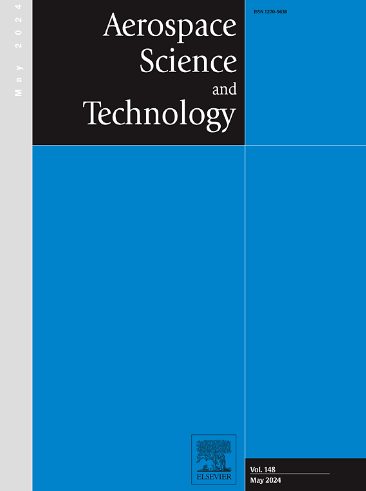孔径和孔数对旋转叶片前缘薄膜冷却性能影响的综合研究
IF 5
1区 工程技术
Q1 ENGINEERING, AEROSPACE
引用次数: 0
摘要
通过实验和数值方法研究了薄膜孔数和直径对旋转叶片前缘薄膜冷却的综合影响。通过压敏涂料技术获得了旋转条件下的薄膜冷却性能。为了更好地理解实验结果,还对数值模拟得到的流场进行了分析。研究了孔长径比 (L/d = 2.5/5/7.5)、孔数 (N = 7/9/10/11/13)、孔直径 (d = 0.64∼1.26 mm)、孔间距 (P/d = 6.3∼9.2) 和孔出口面积 (Ahole/ALE=4 %-14 %) 对薄膜冷却性能的影响。同时还采用了五种吹气比(M = 0.5 至 2.0)。结果表明,孔的长径比(L/d = 2.5∼7.5)对薄膜冷却效果的影响微乎其微。薄膜孔数(N = 10/13)和孔径(d = 0.64/0.75 mm)对各吹气比下的薄膜冷却性能均有单调影响。然而,综合研究表明,在不同的孔数和孔径组合下,区域平均冷却效果与薄膜孔出口总面积之间存在显著的二次相关性。同时,前缘存在一个最佳薄膜孔出口面积,它随着吹气比或质量流量的增加而增大。本文章由计算机程序翻译,如有差异,请以英文原文为准。
A comprehensive investigation of the effect of hole diameter and number on film cooling performance of rotating blade leading edge
The combined effect of film hole number and diameter on the film cooling were investigated on the rotating blade leading edge by using experimental and numerical methods. The film cooling performance was obtained by pressure sensitive paint technique under rotational condition. To better understand the experimental results, the flow fields obtained from numerical simulation were also analyzed. The effects of hole length-to-diameter ratio (L/d = 2.5/5/7.5), hole number (N = 7/9/10/11/13), hole diameter(d = 0.64∼1.26 mm), Hole to hole pitch, (P/d = 6.3∼9.2) and hole exit area (Ahole/ALE=4 %-14 %) on the film cooling performance are investigated. Five blowing ratios are also employed (M = 0.5 to 2.0). The results indicate that the hole length-to-diameter ratios (L/d = 2.5∼7.5) have a negligible influence on the film cooling effectiveness. Both the film hole number (N = 10/13) and the hole diameter (d = 0.64/0.75 mm) monotonically affect the film cooling performance under each blowing ratios. However, a comprehensive study indicates that there is a significant quadratic correlation between the area-averaged cooling effectiveness and the total film hole exit area for different combinations of hole number and diameter. Meanwhile, there is an optimal film hole exit area on the leading edge and it increases as the blowing ratio or mass flow rate increases.
求助全文
通过发布文献求助,成功后即可免费获取论文全文。
去求助
来源期刊

Aerospace Science and Technology
工程技术-工程:宇航
CiteScore
10.30
自引率
28.60%
发文量
654
审稿时长
54 days
期刊介绍:
Aerospace Science and Technology publishes articles of outstanding scientific quality. Each article is reviewed by two referees. The journal welcomes papers from a wide range of countries. This journal publishes original papers, review articles and short communications related to all fields of aerospace research, fundamental and applied, potential applications of which are clearly related to:
• The design and the manufacture of aircraft, helicopters, missiles, launchers and satellites
• The control of their environment
• The study of various systems they are involved in, as supports or as targets.
Authors are invited to submit papers on new advances in the following topics to aerospace applications:
• Fluid dynamics
• Energetics and propulsion
• Materials and structures
• Flight mechanics
• Navigation, guidance and control
• Acoustics
• Optics
• Electromagnetism and radar
• Signal and image processing
• Information processing
• Data fusion
• Decision aid
• Human behaviour
• Robotics and intelligent systems
• Complex system engineering.
Etc.
 求助内容:
求助内容: 应助结果提醒方式:
应助结果提醒方式:


